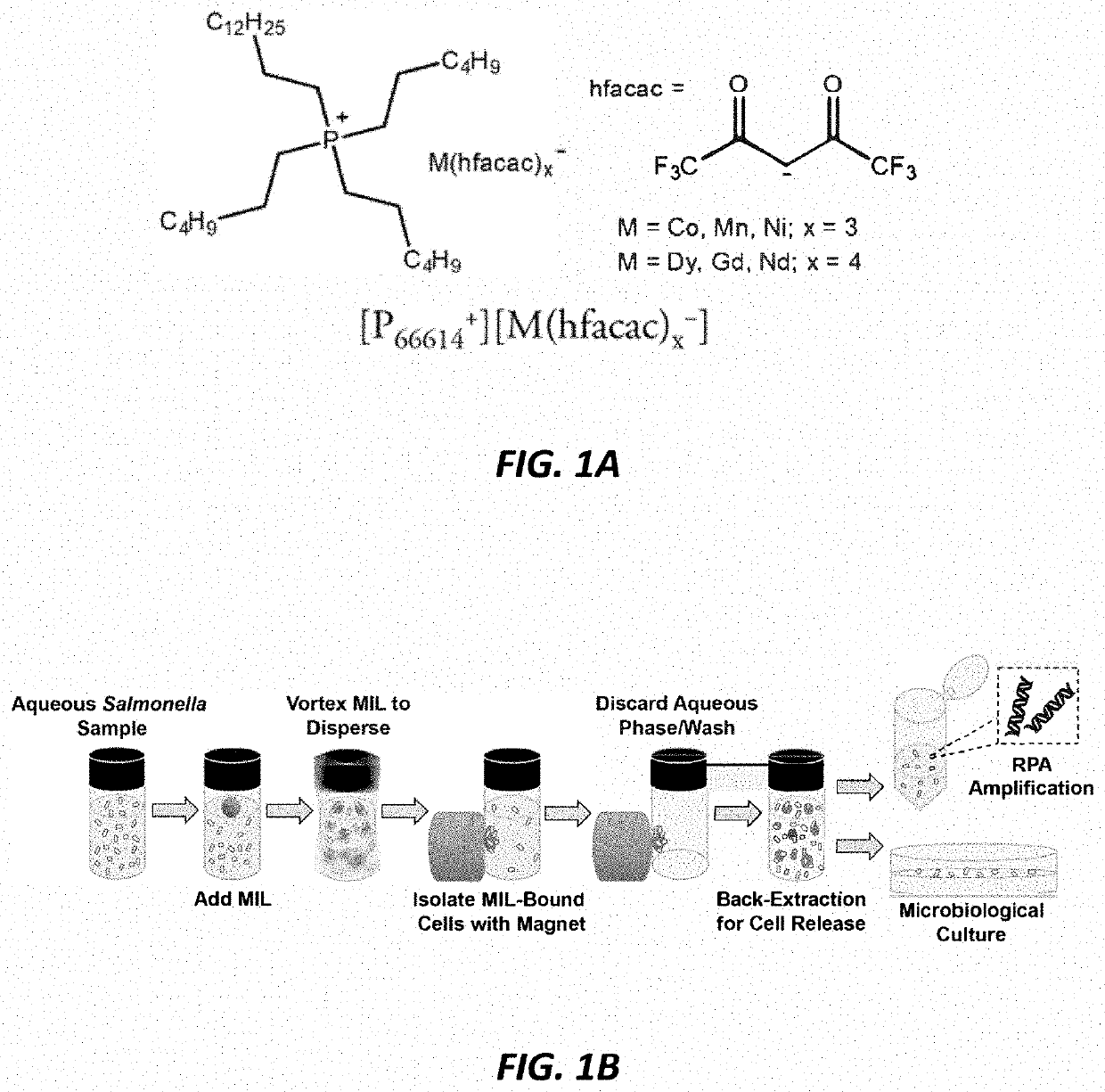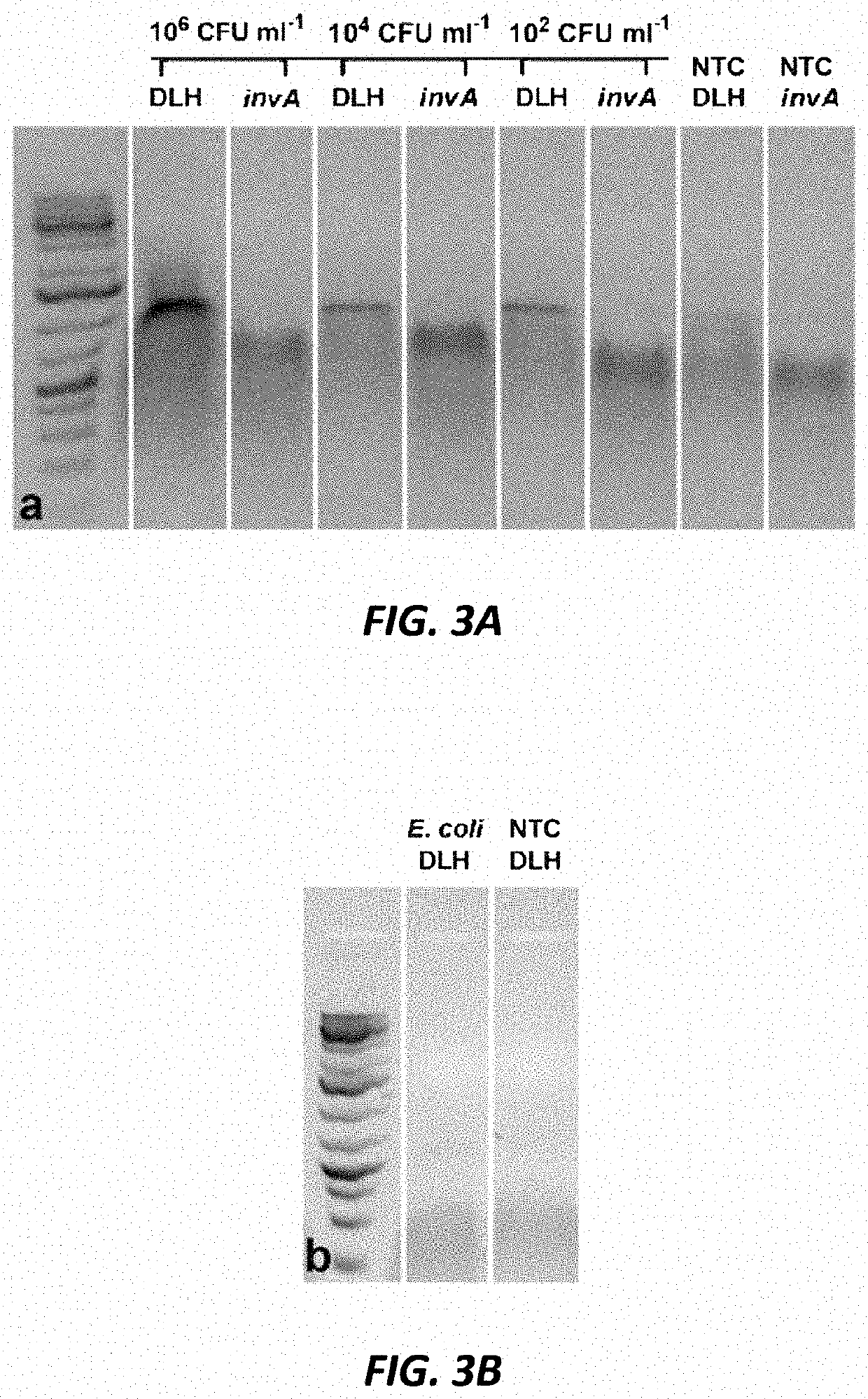Capturing, concentrating, and detecting microbes in a sample using magnetic ionic liquids and recombinase polymerase amplification
a technology of magnetic ionic liquids and recombinase polymerase, which is applied in the direction of group 3/13 organic compounds without c-metal linkages, organic chemistry, group 3/13 organic compounds, etc., can solve the problems of affecting the quality of sample samples, so as to minimize the cost and environmental impact of high-throughput use, capture and detect cells quickly and uniformly, impact quality quality
- Summary
- Abstract
- Description
- Claims
- Application Information
AI Technical Summary
Benefits of technology
Problems solved by technology
Method used
Image
Examples
examples
[0213]Embodiments of the disclosed methods are further defined in the following non-limiting Examples. These Examples, while indicating certain embodiments of the disclosed methods, are given by way of illustration only and should not be considered as limiting in any way. From the above discussion and these Examples, one skilled in the art can ascertain the essential characteristics of this disclosure, and without departing from the spirit and scope thereof, can make various changes and modifications of the embodiments of the disclosed methods to adapt it to various usages and conditions. Thus, various modifications of the embodiments of the disclosed methods, in addition to those shown and described herein, will be apparent to those skilled in the art from the foregoing description. Such modifications are also intended to fall within the scope of the appended claims.
— examples 1 to 6
Materials and Methods—Examples 1 to 6
Magnetic Ionic Liquids
[0214]The structures of the exemplary MIL solvents are shown in FIG. 1A. Synthesis and characterization of the MILs was performed as previously described in U.S. patent application Ser. No. 15 / 950,916. The MIL solvents were purified by liquid-liquid extraction with acetonitrile / hexane and dried in vacuo. The MILs were kept for long-term storage in capped glass vials and MILs were stored in a desiccator for at least 24 h prior to use.
Bacteria and Culture Conditions
[0215]Serratia marcescens (originally from Carolina Biological Supply Company, Burlington, N.C., USA) was sourced from a teaching lab at Iowa State University. Salmonella enterica subspecies enterica ser. Typhimurium ATCC 14028 and Escherichia coli ATCC 25922 were from the American Type Culture Collection (ATCC, Manassas, Va., USA). Overnight cultures (10 mL) of S. marcescens were grown at 25° C. in 250 mL glass Erlenmeyer flasks containing Luria Bertani (LB) broth ...
— examples 7 to 15
Materials and Methods—Examples 7 to 15
Reagents and Magnetic Ionic Liquid Preparation
[0231]Chemical structures of the two MIL solvents examined in these examples are shown in FIG. 7A. Synthesis and characterization of the MILs was performed as previously described. A brief description of MIL synthesis is also provided below. MIL solvents were purified by liquid-liquid extraction with acetonitrile / hexane and dried in vacuo. Prior to all experiments, MILs were stored in a desiccator for at least 24 h.
[0232]The [P6,6,6,14+][Ni(II) (hfacac)3−] [P6,6,6,14+][Dy(III) (hfacac)4−] MILs were synthesized following a previously reported procedure. Briefly, 10 mmol of hexafluoroacetyl acetone was added dropwise into a round bottom flask sealed with a rubber septum containing 10 mmol of ammonium hydroxide in 30 mL of ethanol. After the white vapor formed settled, 3.3 mmol of nickel (II) chloride or 2.5 mmol of dysprosium(III) chloride hexahydrate were added and stirred at room temperature for 5 h....
PUM
| Property | Measurement | Unit |
|---|---|---|
| temperature | aaaaa | aaaaa |
| temperatures | aaaaa | aaaaa |
| temperatures | aaaaa | aaaaa |
Abstract
Description
Claims
Application Information
 Login to View More
Login to View More - R&D
- Intellectual Property
- Life Sciences
- Materials
- Tech Scout
- Unparalleled Data Quality
- Higher Quality Content
- 60% Fewer Hallucinations
Browse by: Latest US Patents, China's latest patents, Technical Efficacy Thesaurus, Application Domain, Technology Topic, Popular Technical Reports.
© 2025 PatSnap. All rights reserved.Legal|Privacy policy|Modern Slavery Act Transparency Statement|Sitemap|About US| Contact US: help@patsnap.com



